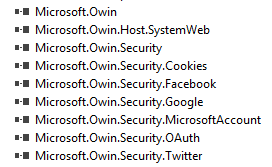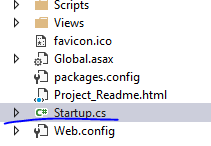Introduction
In the previous post in this series we wrote a couple of OWIN middleware components and chained them together. We actually achieved quite a lot in a low level console application: it hosts a simple web server which receives HTTP requests, it processes the requests with Katana components and performs some elementary logging.
It’s now time to build an application on top of this environment. We’ll build upon the demo console app we’ve been working on so have it ready in Visual Studio. If you’ve read some other topics on this blog then you’ll note that I have a preference for the Web API as the server platform. So let’s see how we can build a Web API application on top of our little server.
Web API demo
Open the Console demo server in Visual Studio. We’ll need to install the following NuGet package:

As the package name implies this package will help us host a Web API 2.1 app using OWIN components. The package installs a number of other components such as WebApi.Core WebApi.Client, JSON.NET, etc. Open the References section in the Solution Explorer. If you’ve worked with the Web API before then some of those new libraries will be familiar to you: System.Net.Http, System.Web.Http and the like.
Add the following class to the project:
public class LatestNews
{
public string Summary { get; set; }
}
We want our web service to show the latest news.
Let’s also add another class called LatestNewsController. It will be our first Web API controller. If you haven’t worked with the Web API before then a Web API controller has the same role as a “normal” controller in an MVC web app. It derives from the “ApiController” base class rather than the “Controller” class in MVC. The LatestNewsController class looks as follows:
public class LatestNewsController : ApiController
{
public HttpResponseMessage Get()
{
LatestNews news = new LatestNews() { Summary = "The world is falling apart." };
return Request.CreateResponse<LatestNews>(HttpStatusCode.OK, news);
}
}
In Startup.Configuration comment out the Use method which dumps out the values in the Environment dictionary. The starting point for this exercise is the following “active” code, the rest should be commented out or removed:
public void Configuration(IAppBuilder appBuilder)
{
appBuilder.Use(async (env, next) =>
{
Console.WriteLine(string.Concat("Http method: ", env.Request.Method, ", path: ", env.Request.Path));
await next();
Console.WriteLine(string.Concat("Response code: ", env.Response.StatusCode));
});
appBuilder.UseWelcomeComponent();
}
Insert a new method stub in Startup.cs that will configure Web API:
private void RunWebApiConfiguration(IAppBuilder appBuilder)
{
}
The key object to configuring the Web API is the HttpConfiguration object located in the System.Web.Http namespace. It opens, among a lot of other things, the gateway to the routing rules. Insert the following body to the above function:
HttpConfiguration httpConfiguration = new HttpConfiguration();
httpConfiguration.Routes.MapHttpRoute(
name: "WebApi"
, routeTemplate: "{controller}/{id}"
, defaults: new { id = RouteParameter.Optional }
);
appBuilder.UseWebApi(httpConfiguration);
This will look very familiar to you if you’ve done any MVC and/or Web API programming – which you probably have otherwise you wouldn’t be reading this post. So we set up out first routing rule using the MapHttpRoute method like in the standard Web API app template of Visual Studio. Finally we call upon the built-in extension of the IAppBuilder interface to declare that we want to use the Web API.
We should be ready to go. Add a call to this method from Configuration():
appBuilder.Use(async (env, next) =>
{
Console.WriteLine(string.Concat("Http method: ", env.Request.Method, ", path: ", env.Request.Path));
await next();
Console.WriteLine(string.Concat("Response code: ", env.Response.StatusCode));
});
RunWebApiConfiguration(appBuilder);
appBuilder.UseWelcomeComponent();
Run the demo app and navigate to localhost:7990/latestnews in a web browser. You should see that our Web API component is indeed responding to the request:

We got the latest news in an XML serialised format. Also, you’ll notice that the middleware that prints the incoming request data in the console window still works:

Now navigate to localhost:7990, i.e. without any controller name. You’ll see that our WelcomeComponent responds with “Hello from the welcome component”. The reason is that the web api component couldn’t route the request to any controller so it let the next component take over. The next component in the pipeline is the WelcomeComponent which happily responds to any request with the same message.
We have just built the basics of a self hosted Web API application which is very light weight, easy to extend and responds to incoming HTTP requests with meaningful data.
Deployment
Let’s try to deploy this application on IIS. Install the following NuGet package:

This package ensures that we can plug in our application into the ASP.NET pipeline.
We’ll also need to change a couple of other things in the application. IIS cannot directly load executables so our setup code in Program.Main is not relevant. Comment out the following chunk of code, all of it, including the Program class declaration:
class Program
{
static void Main(string[] args)
{
string uri = "http://localhost:7990";
using (WebApp.Start<Startup>(uri))
{
Console.WriteLine("Web server on {0} starting.", uri);
Console.ReadKey();
Console.WriteLine("Web server on {0} stopping.", uri);
}
}
}
All the startup infrastructure will be handled by IIS. However, we still want to run the Configuration code in Startup.cs. Open the project properties and turn the project type into a class library:

Also, change the output path to simply ‘bin’ as is expected by IIS:

Build the solution to make sure it still compiles without errors. Check in the bin folder of the project that the [projectname].dll file was created by the build process. I called my project KatanaBasics so I have a KatanaBasics.dll in the bin folder. You’ll need the path to the bin folder in the next step.
We’ll use the iisexpress.exe file to load our this dll. The iisexpress.exe file is usually found here:

Open a command prompt and enter the following command. Make sure you enter the correct path as it appears on your system:

…where the “path” parameter is the path to the bin folder on my computer. Press Enter and if everything goes well then you’ll see the following response:

You’ll notice in the output that IIS will be listening on port 8080 for this application. Navigate to localhost:8080 in a web browser and you should see that… …we get an exception, or at least I got it:

Owin assemblies are updated quite often so it’s almost expected to run into this classic “Could not load file or assembly” error, although it’s really irritating.
Stop the IIS application by pressing “Q” in the command prompt. The solution is quite easy actually. The solution contains an app.config file with the following bit of XML:
<assemblyIdentity name="Microsoft.Owin" publicKeyToken="31bf3856ad364e35" culture="neutral" />
<bindingRedirect oldVersion="0.0.0.0-2.1.0.0" newVersion="2.1.0.0" />
This should do the trick of redirecting old references to an updated one. However, IIS won’t read this file as it is looking for a web.config file instead of app.config. Rename app.config to web.config. Then rebuild the solution, issue the same IIS command as before in the command prompt and navigate to localhost:8080. The WelcomeComponent should respond with “Hello from the welcome component”. Also, you should see the logging output in the command prompt along with some output from IIS itself:

The output of our OWIN middleware has been successfully plugged into the IIS infrastructure. Now check if the web api controller is still responding on localhost:8080/latestnews. You should see that it does indeed.
The OWIN project we’ve built produces a dll which can be referenced from any type of application: console, WPF, WCF, etc., it will always produce valid XML.
How was our application configured correctly now that the Program class has been commented out? How was our Configuration method called now that there’s no code calling it directly? The Host.SystemWeb dll has a bit of code that will look for a class called Startup and run its Configuration method for you automatically.
You can specify the location of the Startup in the appSettings section of web/app.config:
<appSettings>
<add key="owin.appStartup" value="KatanaBasics.Startup"/>
</appSettings>
…where the value is the fully qualified name of the Startup class.
You can also specify it in the AssemblyInfo file:
[assembly: OwinStartup(typeof(KatanaBasics.Startup))]
If you don’t specify these values then it will try to find the Startup class through Reflection in the namespace matching the project name, in this case KatanaBasics. Since there’s one such class in that namespace, the web hosting process found it and executed it.
OWIN, Katana and MVC
Let’s see how OWIN and Katana are incorporated into ASP.NET MVC. In Visual Studio 2013 create a new MVC5 web application. Open the references list and you’ll see that there are several Owin related packages included by default:

You’ll also notice that there’s a Startup.cs in the root of the application:

Open the file and you’ll see the Configuration method which accepts an IAppBuilder object, so it follows the same pattern as we saw in our console based server app. The Configure method calls upon a method called ConfigureAuth. You’ll also notice the assembly metadata above the namespace that tells Katana where to look for the Startup class.
Note that this is a partial class so there’s one more Startup class. You’ll find it in the App_Start folder in a file called Startup.Auth.cs. This is where the ConfigureAuth method is implemented. As the method name suggests ConfigureAuth defines some OWIN middleware that have to do with authentication.
Most of the code is commented out. The two middleware functions that are not commented out are:
- UseCookieAuthentication: to implement cookie authentication, checks if there’s a valid authentication cookie
- UseExternalSignInCookie: for external cookies for third party auth providers
You can uncomment the rest of the code to activate either of the 4 available authentication providers: Microsoft, Twitter, Facebook and/or Google for OAuth2. We will look at these in a later series dedicated to security in MVC5.
Katana sourcecode
If you’re interested in how the Katana components are built then you can check out the sourcecode on the Katana Codeplex page. You’ll see the code for all existing Katana components there:

You can even load the entire code from Git. You’ll find the git clone command on the Codeplex page.
View the list of MVC and Web API related posts here.












